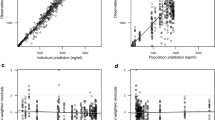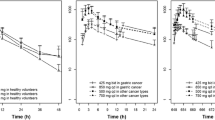Abstract
Background
Imatinib mesylate (Gleevec®) is a small molecule tyrosine kinase inhibitor approved for use in the management of chronic myeloid leukemia in adults and children and in gastrointestinal stromal tumors in adults. Population pharmacokinetic (PPK) studies evaluating the effect of population covariates on the pharmacokinetics of imatinib and its active metabolite have been developed in adults with chronic myeloid leukemia (CML) and gastrointestinal stromal tumor (GIST). However, this still remains to be described in children.
Purpose
The objectives of the analysis were to develop a PPK model of imatinib and its active metabolite, CGP74588, to describe exposure in children and young adults and to identify covariates that are predictors of variability in disposition.
Methods
Plasma concentrations from 26 subjects with Philadelphia (Ph+) leukemia (Phase I study) and 15 subjects with refractory solid tumors (Phase II study), who received oral imatinib at doses ranging from 260 to 570 mg/m2, were available for the PPK analysis in NONMEM. Blood samples were drawn prior to dosing and over 24–48 h on days 1 and 8 of the studies. Covariates studied included weight, age, albumin, alanine aminotransferase and the study population.
Results
The pharmacokinetics of imatinib and CGP 74588 were well described by one and two compartment models, respectively. Total body weight was the only covariate found to significantly affect Cl/F and V/F. The final imatinib-CGP 74588 model is summarized as follows: CL/F imatinib (L/h) = 10.8 × (WT/70)0.75, V/F imatinib (L) = 284 × (WT/70) and D1duration of zero order absorption,imatinib (h) = 1.67 and CL/F CGP 74588 (L/h) = 9.65 × (WT/70)0.75, V1/F CGP 74588 (L) = 11.6 × (WT/70), Q CGP 74588 (L/h) = 2.9 × (WT/70)0.75 and V2/F CGP 74588 (L) = 256*(WT/70). Model evaluation indicated that the final model was robust and satisfactory.
Conclusions
Current imatinib dosing guidelines in pediatrics is based on the achievement of exposures consistent with doses known to be safe and efficacious in adults. Dose adjustments in children are guided empirically by the observance of drug-related toxicities. While, the pharmacokinetics of imatinib and its active metabolite, CGP 74588 in children are consistent with prior knowledge in adults, the model will form the basis to support the design of future trials, particularly with a view to managing toxicities and exploring dosing in this population.





Similar content being viewed by others
References
Abdiu A, Wingren S, Larsson SE, Wasteson A, Walz TM (1999) Effects of human platelet-derived growth factor-AB on sarcoma growth in vitro and in vivo. Cancer Lett 141:39–45
Bakhtiar R, Lohne J, Ramos L, Khemani L, Hayes M, Tse F (2002) High-throughput quantification of the anti-leukemia drug STI571 (Gleevec) and its main metabolite (CGP 74588) in human plasma using liquid chromatography–tandem mass spectrometry. J Chromatogr B Analyt Technol Biomed Life Sci 768:325–340
Bartelink IH, Rademaker CM, Schobben AF, van den Anker JN (2006) Guidelines on paediatric dosing on the basis of developmental physiology and pharmacokinetic considerations. Clin Pharmacokinet 45:1077–1097
Beal SL, Sheiner LB (1992) NONMEM users guides. NONMEM Project Group, University of California at San Francisco
Bond M, Bernstein ML, Pappo A, Schultz KR, Krailo M, Blaney SM, Adamson PC (2007) A phase II study of imatinib mesylate in children with refractory or relapsed solid tumors: a children’s oncology group study. Pediatr Blood Cancer
Champagne MA, Capdeville R, Krailo M, Qu W, Peng B, Rosamilia M, Therrien M, Zoellner U, Blaney SM, Bernstein M (2004) Imatinib mesylate (STI571) for treatment of children with Philadelphia chromosome-positive leukemia: results from a children’s oncology group phase 1 study. Blood 104:2655–2660
Cohen MH, Williams G, Johnson JR, Duan J, Gobburu J, Rahman A, Benson K, Leighton J, Kim SK, Wood R, Rothmann M, Chen G, U KM, Staten AM, Pazdur R (2002) Approval summary for imatinib mesylate capsules in the treatment of chronic myelogenous leukemia. Clin Cancer Res 8:935–942
Dagher R, Cohen M, Williams G, Rothmann M, Gobburu J, Robbie G, Rahman A, Chen G, Staten A, Griebel D, Pazdur R (2002) Approval summary: imatinib mesylate in the treatment of metastatic and/or unresectable malignant gastrointestinal stromal tumors. Clin Cancer Res 8:3034–3038
de Wildt SN, Kearns GL, Leeder JS, van den Anker JN (1999) Cytochrome P450 3A:ontogeny and drug disposition. Clin Pharmacokinet 37:485–505
Deininger MW, Goldman JM, Lydon N, Melo JV (1997) The tyrosine kinase inhibitor CGP57148B selectively inhibits the growth of BCR-ABL-positive cells. Blood 90:3691–3698
Delbaldo C, Chatelut E, Re M, Deroussent A, Seronie-Vivien S, Jambu A, Berthaud P, Le Cesne A, Blay JY, Vassal G (2006) Pharmacokinetic–pharmacodynamic relationships of imatinib and its main metabolite in patients with advanced gastrointestinal stromal tumors. Clin Cancer Res 12:6073–6078
Druker BJ, Tamura S, Buchdunger E, Ohno S, Segal GM, Fanning S, Zimmermann J, Lydon NB (1996) Effects of a selective inhibitor of the Abl tyrosine kinase on the growth of Bcr-Abl positive cells. Nat Med 2:561–566
FDA (2003) FDA approves Gleevec for pediatric leukemia. FDA Consum 37(4):6
Gschwind HP, Pfaar U, Waldmeier F, Zollinger M, Sayer C, Zbinden P, Hayes M, Pokorny R, Seiberling M, Ben-Am M, Peng B, Gross G (2005) Metabolism and disposition of imatinib mesylate in healthy volunteers. Drug Metab Dispos 33:1503–1512
Heinrich MC, Griffith DJ, Druker BJ, Wait CL, Ott KA, Zigler AJ (2000) Inhibition of c-kit receptor tyrosine kinase activity by STI 571, a selective tyrosine kinase inhibitor. Blood 96:925–932
Holford NH (2005) The visual predictive check—superiority to standard diagnostic plots. In: 2005 population approach group in Europe (PAGE) annual meeting, Pamplona, Spain
Judson I, Ma P, Peng B, Verweij J, Racine A, di Paola ED, van Glabbeke M, Dimitrijevic S, Scurr M, Dumez H, van Oosterom A (2005) Imatinib pharmacokinetics in patients with gastrointestinal stromal tumour: a retrospective population pharmacokinetic study over time. EORTC soft tissue and bone sarcoma group. Cancer Chemother Pharmacol 55:379–386
le Coutre P, Kreuzer KA, Pursche S, Bonin M, Leopold T, Baskaynak G, Dorken B, Ehninger G, Ottmann O, Jenke A, Bornhauser M, Schleyer E (2004) Pharmacokinetics and cellular uptake of imatinib and its main metabolite CGP74588. Cancer Chemother Pharmacol 53:313–323
Neville K, Parise RA, Thompson P, Aleksic A, Egorin MJ, Balis FM, McGuffey L, McCully C, Berg SL, Blaney SM (2004) Plasma and cerebrospinal fluid pharmacokinetics of imatinib after administration to nonhuman primates. Clin Cancer Res 10:2525–2529
Nikolova Z, Peng B, Hubert M, Sieberling M, Keller U, Ho YY, Schran H, Capdeville R (2004) Bioequivalence, safety, and tolerability of imatinib tablets compared with capsules. Cancer Chemother Pharmacol 53:433–438
Novartis Pharma Stein AG (2003) Gleevec® (imatinib mesylate): prescribing information [online]
Peng B, Dutreix C, Mehring G, Hayes MJ, Ben-Am M, Seiberling M, Pokorny R, Capdeville R, Lloyd P (2004) Absolute bioavailability of imatinib (Glivec) orally versus intravenous infusion. J Clin Pharmacol 44:158–162
Peng B, Hayes M, Resta D, Racine-Poon A, Druker BJ, Talpaz M, Sawyers CL, Rosamilia M, Ford J, Lloyd P, Capdeville R (2004) Pharmacokinetics and pharmacodynamics of imatinib in a phase I trial with chronic myeloid leukemia patients. J Clin Oncol 22:935–942
Peng B, Lloyd P, Schran H (2005) Clinical pharmacokinetics of imatinib. Clin Pharmacokinet 44:879–894
Ramalingam S, Lagattuta TF, Egorin MJ, Hayes MJ, Ramanathan RK (2004) Biliary excretion of imatinib mesylate and its metabolite CGP 74588 in humans. Pharmacotherapy 24:1232–1235
Savage DG, Antman KH (2002) Imatinib mesylate–a new oral targeted therapy. N Engl J Med 346:683–693
Schmidli H, Peng B, Riviere GJ, Capdeville R, Hensley M, Gathmann I, Bolton AE, Racine-Poon A (2005) Population pharmacokinetics of imatinib mesylate in patients with chronic-phase chronic myeloid leukaemia:results of a phase III study. Br J Clin Pharmacol 60:35–44
Sjoblom T, Shimizu A, O’Brien KP, Pietras K, Dal Cin P, Buchdunger E, Dumanski JP, Ostman A, Heldin CH (2001) Growth inhibition of dermatofibrosarcoma protuberans tumors by the platelet-derived growth factor receptor antagonist STI571 through induction of apoptosis. Cancer Res 61:5778–5783
Sulzbacher I, Traxler M, Mosberger I, Lang S, Chott A (2000) Platelet-derived growth factor-AA and -alpha receptor expression suggests an autocrine and/or paracrine loop in osteosarcoma. Mod Pathol 13:632–637
Wilkinson GR (1996) Cytochrome P4503A (CYP3A) metabolism: prediction of in vivo activity in humans. J Pharmacokinet Biopharm 24:475–490
Yano Y, Beal SL, Sheiner LB (2001) Evaluating pharmacokinetic/pharmacodynamic models using the posterior predictive check. J Pharmacokinet Pharmacodyn 28:171–192
Acknowledgments
The authors thank Drs. Y. Wang and H. Schmidli, Novartis Pharma AG, for providing them with the NONMEM script from their previously published Gleevec PPK model in adults.
Author information
Authors and Affiliations
Corresponding author
Rights and permissions
About this article
Cite this article
Menon-Andersen, D., Mondick, J.T., Jayaraman, B. et al. Population pharmacokinetics of imatinib mesylate and its metabolite in children and young adults. Cancer Chemother Pharmacol 63, 229–238 (2009). https://doi.org/10.1007/s00280-008-0730-x
Received:
Accepted:
Published:
Issue Date:
DOI: https://doi.org/10.1007/s00280-008-0730-x




